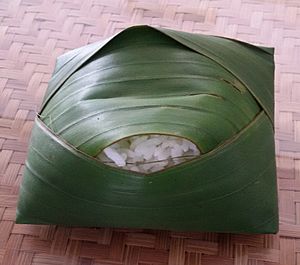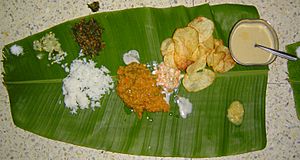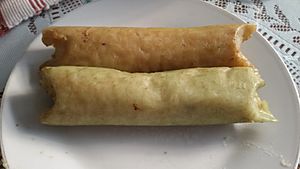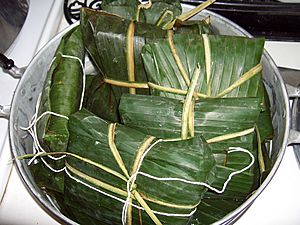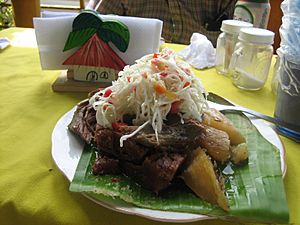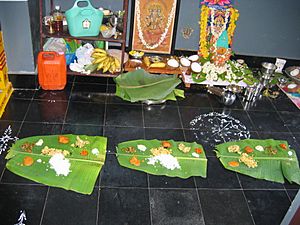Banana leaf facts for kids
The banana leaf is the big, green leaf of the banana plant. A single banana plant can grow up to 40 leaves! These leaves are super useful because they are large, bendy, waterproof, and look nice.
People in warm, tropical places use banana leaves for many things. They are great for cooking, wrapping food, and serving meals. They are also used for decorations and in special ceremonies, especially in Hindu and Buddhist traditions. In some traditional homes, dry banana leaves are even used to make roofs and fences. Long ago, in parts of South and Southeast Asia, banana and palm leaves were often used as paper for writing.
Contents
Banana Leaves in Cooking
Banana leaves are perfect for cooking because they are big, flexible, and don't let water through. When food is cooked in or served on them, the leaves give a special smell and a slightly sweet taste to the dish. The leaves themselves are not eaten; they are usually thrown away after the meal.
Besides adding flavor, banana leaves help keep food juicy and stop it from burning, much like aluminum foil. In some places, like Tamil Nadu in India, dried banana leaves are used to pack food or are shaped into cups for liquids. Some recipes from South India, the Philippines, and Cambodia use banana leaves to wrap food for frying. The leaves are taken off before eating. In Vietnam, banana leaves are used to wrap foods like cha-lua.
Cooking Around the World
In many parts of India and Sri Lanka, especially in the south, it's a tradition to serve meals on a banana leaf. This is very common during festivals. In Bengali cuisine, a dish called Paturi is made by steaming fish wrapped inside a banana leaf.
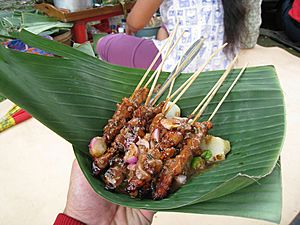
In Indonesian cuisine, banana leaves are used for cooking methods like pepes and botok, where food packets are steamed, boiled, or grilled. They also wrap snacks and sticky rice dishes like lemper and lontong. In Java, a banana leaf can be folded into a cone-shaped plate called a pincuk to serve dishes like pecel or satay. This is like a traditional, disposable take-away container!
In Malaysia and Singapore, banana leaves wrap snacks like kuih and otak-otak. They are also used to wrap nasi lemak because they make the rice smell wonderful.

In the Philippines, it's common to serve food on large banana leaves for a shared meal called a salo-salo, where everyone eats with their hands. Banana leaves are also used to wrap foods like suman and bibingka, adding a nice smell to the food.
In Mexico, especially in Oaxaca, tamales and a type of barbacoa taco are often steamed in banana leaves. The traditional Yucatán dish Cochinita pibil also uses banana leaves to wrap pork.
Throughout Central America, tamales are traditionally wrapped in banana leaves before cooking. This gives the corn dough a special taste. For example, Nacatamal in Nicaragua is a big tamale wrapped in banana leaves, filled with pork, rice, potatoes, and vegetables.
Another Nicaraguan dish is Vigorón, which is a salad of cabbage, yuca, and fried pork, all wrapped in a banana leaf. Vaho (or Baho) is a mix of meat, green plantains, and yuca cooked inside banana leaves.
In Ecuador, dishes like Bollo (green plantain and peanut butter batter with fish or pork) are wrapped in banana leaves and then baked or steamed. In the Amazonian provinces, Maito is grilled fish served with yuca and rice, wrapped in banana leaves.
Banana Leaves in Tradition and Religion
Banana leaves are used as decorations for special events, weddings, and ceremonies in southern India and Southeast Asia by Hindus and Buddhists. For example, Balinese Hindus make small containers from banana leaves called canang for flower offerings to spirits and gods. These offerings are placed around the house.
In Thailand, banana leaves are used to make a beautiful offering bowl called a krathong. This is an important part of the Loy Krathong festival. During this festival, people float krathongs on water to show respect to the Mother of Water. A krathong is shaped like a lotus flower and holds flowers, incense sticks, and a candle. People believe that floating a krathong carries away their bad luck and brings happiness. Banana leaves are perfect for krathongs because they are natural and break down easily in water.
Banana Leaves as Writing Surfaces
Long ago, banana and palm leaves were the main surfaces for writing in many countries in South and Southeast Asia. This even affected how their writing styles developed! The round shapes of letters in many scripts from southern India, Sri Lanka, and Southeast Asia (like Oriya, Sinhala, Burmese, and Javanese) are thought to have been influenced by writing on leaves. If you tried to draw sharp angles or straight lines along the veins of the leaf with a sharp tool, the leaf might split. So, rounded letters or lines that only went up-and-down or diagonally were better for daily use.
The natural ribs of the leaves acted like the lines on ruled paper, separating lines of text. Some people even think this influenced the rongorongo script of Easter Island. Later wooden tablets for this script were grooved to look like a banana leaf.
Other Uses
Scientists have found that banana leaves contain a substance called apiin, which can be used to make tiny particles called nanoparticles for new products. Banana leaves have also been suggested as a material for making trays for airline meals to help the environment.
Images for kids
See also
 In Spanish: Hoja de banana para niños
In Spanish: Hoja de banana para niños


